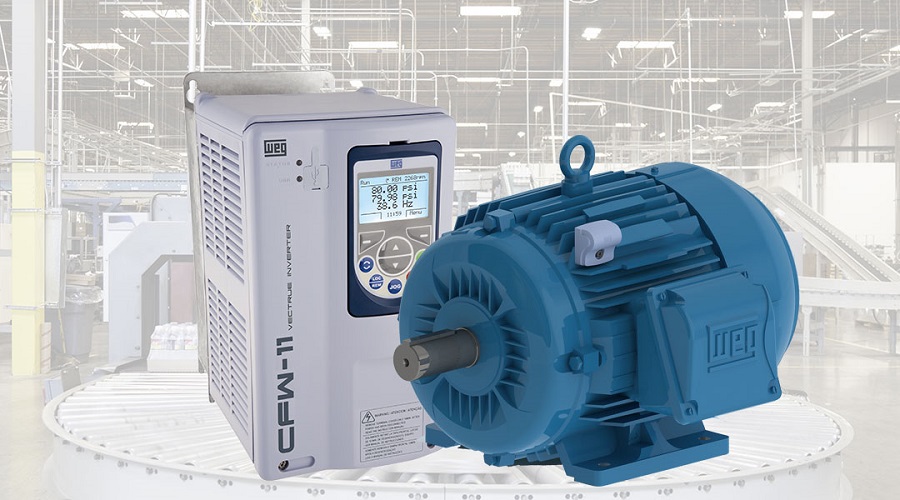With growing pressure on the food industry’s profit margins, companies must look to reduce manufacturing costs wherever possible. The food industry is incredibly energy intensive, accounting for around 30 percent of global energy consumption and as a result, improving efficiency offers an opportunity to reduce costs. Here, Marek Lukaszczyk, European and Middle East marketing manager at the global manufacturer of electric motors, drives and gearboxes, WEG, explains how energy efficient motors and variable speed drives (VSDs) can help.
Increasing pressure is being placed on food and beverage companies to minimise wastage and improve resource use. Costs of raw materials, energy and labour are rising, while consumer demand for low prices increases, leading to intense competition and strict pricing pressure from retailers. Consequently, it is becoming increasingly difficult to maintain decent margins.
The food and beverage industry is also highly dependent on energy supply. Fluctuations in price and availability have the potential to cause major supply chain disruption — particularly due to price rises for carbon dioxide. Therefore, making food and drink production facilities as energy efficient as possible is essential to build a more resilient, futureproof business.
It makes sense, then, that many food manufacturers are looking for ways to improve the efficiency of their production. In fact, according to energy experts Centrica Solutions, 45 per cent of sustainable businesses are transforming energy data into actionable improvements.
Many of the most energy consuming processes in the food and beverage industry involve electric motors. Milling and centrifuging during sugar processing, grinding in flour production or even chilling frozen food products, are all driven by electric motors, and that’s just for starters.
Managing existing motors
The first step to improving energy efficiency in food manufacturing is taking stock of the status of existing motors. Food production relies on motors to power a whole host of processes, from conveyors and mixers to fans, pumps and refrigerators. However, many of the motors used in these applications could be oversized. Motors in applications like fans and pumps traditionally run at a partial load, using a valve, brake or throttle. However, this means that motors could be working harder than necessary, and by using mechanical speed control energy is wasted.

By choosing a motor of the appropriate size, or connecting a variable speed drive (VSD), food manufacturers can ensure motors are consuming only the necessary energy to power their equipment. VSDs enable motors to be run at a partial load more efficiently, as they directly control a motor’s speed and torque — the motor can be controlled to match demand, resulting in high energy efficiency even at different speeds.
Invest for long-term gains
It's also important to consider the age and condition of motors within a production facility. Older motors may have been rewound numerous times within their lifecycle. Whilst motors can be rewound to their original efficiency levels, in many cases this is not achieved.
Plus, older motors that require rewinding are often significantly less energy efficient than the latest models, thanks to years of technical advancements. In fact, thanks to pressure on governments to meet environmental targets, all new electric motors in the EU and the UK must now meet stringent energy efficiency regulations, depending on motor type and application. For example, as of July 2021 all new three-phase motors, the kind typically used in many food and drink applications, must meet IE3 standards.
It can often be the case that choosing to rewind a motor, rather than purchase a new one, offers a short-term cost benefit, but will result in manufacturers paying significantly more in the long run due to higher energy consumption. In fact, the energy cost to run an electric motor over ten years is at least 30 times the original purchase price, meaning new, energy efficient motors may quickly provide a return on the initial investment.
Replacing oversized ageing motors with new, correctly sized ones in line with IE3 or IE4 efficiency standards, represents significant energy savings for food manufacturers, particularly when used in combination with a VSD. But, how can facility managers know when existing motors need replacing?
Smart sensors for motor monitoring
The retrofitting of smart sensors to existing motors allows plant managers access to real-time, continuous data on motor performance. These sensors can monitor parameters such as vibration or temperature and alert engineers of any deviation from optimal performance.
WEG’s Motor Scan® solution consists of a sensor, easily attached to the motor fin, which communicates data to the cloud and enables analysis through WEG’s fleet management products. WEG Motor Specialist relies on machine learning and artificial intelligence (AI) to diagnose, monitor and indicate the need for predictive maintenance in electric motors.
WEG Motor Scan autonomously sends alerts when motors are running sub-optimally, enabling engineers to take steps to either repair or replace the motor in question. This avoids energy wastage and unexpected downtime — especially important in the food and beverage industry where the uncontrolled shutdown of a mixer or chiller can result in the loss of entire product batches.
By implementing strategies to gain additional insight into motor efficiency, ensuring motors are the right size for the application, and replacing ageing models with new energy efficient motors, food and beverage manufacturers can make significant energy savings. A more efficient plant brings with it improved profit margins, increased resilience and agility, and enhanced environmental credentials. With benefits such as these, taking steps to improve energy performance of motors in food production is an obvious choice.














